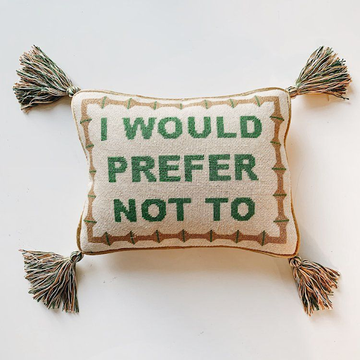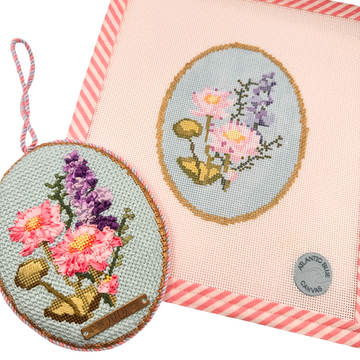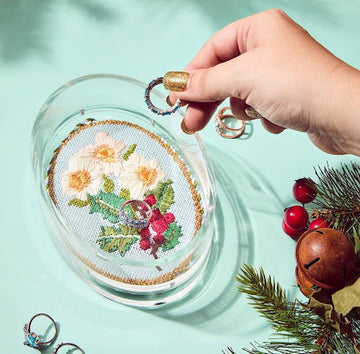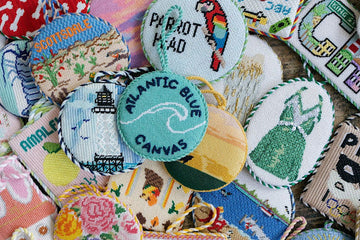Introduction
If you’re aiming for a needlepoint project that looks polished, professional, and free from uneven tension, the basket stitch needlepoint is one technique you can’t afford to skip. This stitch is a go-to for large background areas because it delivers even coverage, minimizes canvas distortion, and creates a smooth surface that frames your focal design beautifully.
Whether you’re brand new to needlepoint or have been stitching for years, learning how to do basket stitch needlepoint will instantly improve the finish of your work. In this tutorial, we’ll cover everything from its definition and benefits to step-by-step instructions, materials, common mistakes, and expert finishing tips.
Key Takeaways
The basket stitch needlepoint (basketweave stitch) is ideal for large backgrounds and smooth coverage.
- It prevents canvas distortion better than tent stitch.
- Choosing the right thread, canvas, and needle size improves results.
- Even tension and correct stitch direction are essential.
- Proper finishing steps—like blocking and securing threads—make a big difference.
Section 1: What is Basket Stitch Needlepoint?
The basket stitch needlepoint—also known as the basketweave stitch needlepoint—is a variation of the tent stitch. It’s worked diagonally across the canvas rather than in straight horizontal or vertical rows. This diagonal structure evenly distributes tension across the fabric, preventing the puckering or distortion that can happen with some other stitches.
How It Differs from Tent Stitch
-
Tent Stitch: Worked in rows, which can pull the canvas unevenly if done over large areas. It’s quicker for small motifs but less ideal for backgrounds.
-
Basketweave Stitch Needlepoint: Stitches follow the diagonal weave of the canvas mesh, producing balanced tension and a cleaner finish. It’s slightly slower to stitch but results in a smoother, professional background.
Why It’s Preferred for Backgrounds:
-
Prevents visible lines between rows.
-
Gives a uniform, tightly woven appearance.
- Works well for both small and large-scale designs.
Section 2: Materials & Canvas Preparation
Before you start your basket stitch needlepoint tutorial, having the right supplies is key to achieving professional results.
Ideal Needlepoint Canvas
-
Mesh Size:
-
13-mesh canvas: Great for larger designs and thicker threads.
-
18-mesh canvas: Perfect for detailed work and finer threads.
-
13-mesh canvas: Great for larger designs and thicker threads.
-
Canvas Color: Neutral colors like white, ivory, or beige work best for learning.
Thread Types
-
Wool Yarn: Durable and gives great coverage—ideal for traditional projects.
-
Cotton Floss: Smooth texture, perfect for crisp and clean finishes.
-
Silk Thread: Luxurious, with a subtle sheen for elegant backgrounds.
Additional Tools
-
Needles: Tapestry needles in sizes 20–24 depending on your canvas mesh.
-
Frame or Hoop: Keeps the canvas taut, helping maintain even tension.
-
Thread Conditioner: Optional, but helps reduce tangling and fraying.
Pro Tip: Always work with a length of thread no longer than 18 inches to avoid wear and fuzzing.
Section 3: How to Do Basket Stitch Needlepoint
Follow these simple steps to master the basket stitch needlepoint technique:
-
Identify the Canvas Diagonal
Look closely at your canvas—it’s woven in a grid with vertical and horizontal threads. For basket stitch, you’ll be working along the diagonal grain.
-
Start in the Upper Right Corner
If you’re right-handed, this is the most comfortable starting point (left-handed stitchers may start in the upper left).
-
Work Downward Diagonally
Bring your needle up at the bottom left of a mesh hole and down at the top right, covering one diagonal thread of the canvas.
-
Continue Across the Diagonal Row
Follow the same slant for each stitch until you reach the edge of your section.
-
Change Direction for Next Row
The back of your work should show vertical and horizontal stitches, never diagonal ones. This is a sign you’re distributing tension correctly.
-
Maintain Consistent Tension
Pull the thread just tight enough to lay flat against the canvas without puckering.
Section 4: When to Use Basket Stitch
The basket stitch needlepoint background technique works best in these situations:
-
Large Background Areas: Prevents streaking or visible seams between rows.
-
Solid Color Sections: Gives smooth, even coverage that looks clean and professional.
-
Reducing Canvas Distortion: Essential for projects that will be framed or mounted, as it keeps edges straight.
- High-Wear Items: Such as cushions or upholstery panels, since the stitch is durable and resists snagging.
Also read: Needlepoint Stockings for Christmas: From Canvas to Mantel
Section 5: Common Mistakes & Fixes
|
Mistake |
Problem |
Fix |
|
Uneven tension |
Background looks bumpy |
✅Use a frame and practice even pulls |
|
Wrong stitch direction |
Canvas distorts |
✅Keep backs vertical/horizontal |
|
Skipping threads |
Gaps appear |
✅Count carefully |
|
Fraying thread |
Thread looks fuzzy |
✅Use shorter lengths and conditioner |
Section 6: Professional Finishing Tips
To give your basketweave stitch needlepoint the polished look it deserves:
-
Blocking: Wet or steam block the piece to square it back to its original shape.
-
Securing Threads: Weave thread tails into the back for at least an inch to prevent unraveling.
-
Trimming & Mounting: Leave a 2-inch margin around the design for framing.
-
Cleaning: If necessary, gently spot-clean with mild soap and water—never wring or twist the canvas.
Also Read: Needlepoint Stitches: The Complete Beginner-to-Expert Guide
FAQs
Q1: What’s the difference between tent stitch and basket stitch needlepoint?
Tent stitch works in rows and can distort the canvas, while basket stitch follows the diagonal grain, preventing distortion and giving more even coverage.
Q2: Is basketweave stitch harder than tent stitch?
It’s slightly more complex to learn but becomes just as quick once you’re comfortable.
Q3: What thread works best for basket stitch needlepoint backgrounds?
Wool yarn provides excellent coverage, but cotton and silk are also great depending on the project’s texture and finish.
Q4: Can I mix basket stitch with other needlepoint background stitches?
Yes, you can combine basket stitch with stitches like continental or decorative patterns for unique effects.
Q5: How do I avoid uneven tension?
Use a frame to keep the canvas taut and keep your pull gentle but consistent across all stitches.
Conclusion
The basket stitch needlepoint is more than just a background filler—it’s a foundation technique that ensures your finished project looks professional, durable, and perfectly balanced. By using the right materials, following the correct stitch path, and practicing consistent tension, you’ll achieve a finish that enhances your entire design.
For more tips, explore our Beginner’s Guide to Needlepoint, or compare Tent Stitch vs Basketweave Stitch to see which works best for different projects.
Ready to explore more advanced stitches? Read our blog on mastering advanced stitches after the basics.





